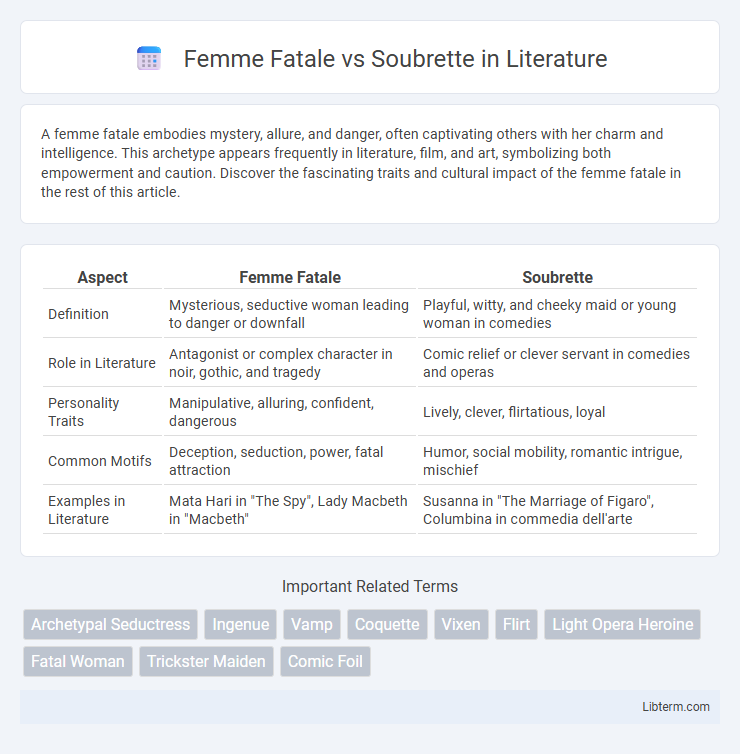A femme fatale embodies mystery, allure, and danger, often captivating others with her charm and intelligence. This archetype appears frequently in literature, film, and art, symbolizing both empowerment and caution. Discover the fascinating traits and cultural impact of the femme fatale in the rest of this article.
Table of Comparison
| Aspect | Femme Fatale | Soubrette |
|---|---|---|
| Definition | Mysterious, seductive woman leading to danger or downfall | Playful, witty, and cheeky maid or young woman in comedies |
| Role in Literature | Antagonist or complex character in noir, gothic, and tragedy | Comic relief or clever servant in comedies and operas |
| Personality Traits | Manipulative, alluring, confident, dangerous | Lively, clever, flirtatious, loyal |
| Common Motifs | Deception, seduction, power, fatal attraction | Humor, social mobility, romantic intrigue, mischief |
| Examples in Literature | Mata Hari in "The Spy", Lady Macbeth in "Macbeth" | Susanna in "The Marriage of Figaro", Columbina in commedia dell'arte |
Understanding the Femme Fatale Archetype
The Femme Fatale archetype embodies a mysterious, seductive woman whose charm and allure often lead others into danger or deception. Characterized by independence, intelligence, and a daring spirit, she contrasts sharply with the Soubrette, who is typically playful, submissive, and comedic. Understanding the Femme Fatale involves recognizing her role as a powerful, enigmatic force in literature and film, often representing themes of temptation, power, and moral ambiguity.
The Soubrette: Characteristics and Origins
The soubrette is a lively and coquettish character type often seen in opera, musical theatre, and comedy, characterized by her playful, flirtatious demeanor and quick wit. Originating from the French theatrical tradition, the soubrette typically serves as a maid or confidante who uses charm and cleverness to influence events and outsmart others. This archetype contrasts with the femme fatale by embodying innocence and humor rather than danger and seduction.
Historical Evolution of Femme Fatale and Soubrette
The historical evolution of the femme fatale traces back to ancient mythologies and early literature, where seductive women symbolized danger and power, evolving through Gothic and noir cinema into a complex archetype of mysterious allure and psychological depth. The soubrette, originating in 18th-century French opera and theater, developed as a clever, coquettish maid archetype known for wit and charm, reflecting social class distinctions and comic relief in performance arts. Both archetypes have evolved to challenge and reflect shifting societal norms about gender, sexuality, and power across centuries of cultural expression.
Key Differences Between Femme Fatale and Soubrette
Femme Fatale characters exude mystery, seduction, and danger, often manipulating others to achieve their goals, contrasting sharply with Soubrette roles, which are characterized by youthful charm, wit, and playful servitude. While Femme Fatales embody power and allure through calculated actions, Soubrettes provide comic relief and light-hearted interactions in theatrical and operatic works. The key differences lie in their narrative functions, emotional depth, and the intensity of their interpersonal dynamics within stories.
Famous Femme Fatales in Literature and Film
Famous femme fatales in literature and film include iconic characters like Lady Macbeth from Shakespeare's Macbeth, whose manipulative and ambitious nature drives the plot, and film noir staples such as Phyllis Dietrichson in Double Indemnity, embodying seduction and danger. These femmes fatales contrast sharply with soubrettes, who are typically playful, witty, and subservient maids or young women in comedies, exemplified by characters like Soubrette roles in Mozart's operas. The femme fatale's power lies in her ability to manipulate others to her advantage, often leading to the downfall of male protagonists.
Iconic Soubrettes in Theatre and Cinema
Iconic soubrettes in theatre and cinema, such as Marilyn Monroe in "Gentlemen Prefer Blondes" and Lucille Ball in "I Love Lucy," embody playful, witty, and charming characters who often serve as comedic relief and romantic interests. Unlike the Femme Fatale, who exudes mystery and danger, soubrettes are characterized by their youthful energy, flirtatious behavior, and often lighthearted naivety, making them memorable archetypes in classic musical comedies and farcical plays. Their presence enriches narratives by providing a contrast to more serious or seductive roles, highlighting the dynamic range of female characterizations in performing arts.
Psychological Dimensions: Femme Fatale vs Soubrette
The Femme Fatale embodies complex psychological dimensions such as manipulation, seduction, and dominance, often projecting power through enigmatic allure and emotional control. In contrast, the Soubrette represents lightheartedness, wit, and subservient charm, characterized by vulnerability and playful innocence that evoke emotional softness. These archetypes showcase divergent psychological strategies in interpersonal dynamics, with the Femme Fatale leveraging fear and fascination, while the Soubrette fosters trust and sympathy.
Gender Roles and Stereotypes in Entertainment
The Femme Fatale archetype in entertainment embodies powerful, seductive women who manipulate gender expectations to assert control, often challenging traditional passive female roles. In contrast, the Soubrette character reinforces stereotypes of youthful, playful femininity, typically portraying subservient or coquettish traits that emphasize innocence and compliance. Both archetypes reveal how gender roles are constructed and perpetuated in media, reflecting societal attitudes towards female agency and sexuality.
Cultural Impact of Femme Fatale and Soubrette Archetypes
The Femme Fatale archetype has significantly influenced cultural narratives by embodying power, mystery, and seduction, often challenging traditional gender roles through its portrayal in film noir, literature, and art. In contrast, the Soubrette archetype represents a lighter, playful form of femininity, commonly found in opera and theater as a witty, charming servant, symbolizing social mobility and subversion within rigid class structures. Both archetypes have shaped societal perceptions of women, with the Femme Fatale highlighting themes of danger and empowerment, while the Soubrette emphasizes humor and cleverness in navigating social hierarchies.
Modern Interpretations: Are the Lines Blurring?
Modern interpretations increasingly blur the lines between Femme Fatale and Soubrette archetypes, reflecting evolving gender roles and complex characterizations in contemporary media. Femme Fatales now exhibit playful, mischievous traits traditionally associated with Soubrettes, while Soubrettes gain depth with subtle elements of seduction and empowerment. This fusion challenges classical distinctions, creating multifaceted female roles that resonate with modern audiences seeking nuanced portrayals.
Femme Fatale Infographic

 libterm.com
libterm.com